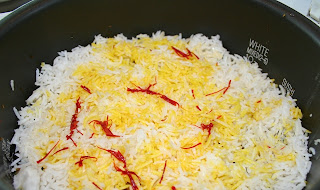The cooked basmati rice to be used for this dish is not supposed to be sticky. I learned a new trick that if the uncooked basmati rice is rinsed in cold water a lot of times until the water runs clear, the rice won't stick together when they are cooked in a rice cooker or in a pot. The starch in raw rice is the cause of the stickiness. Another trick I found out is to take the rice out and spread them on a cookie sheet to cool right after the rice cooker beeped to tell you that it is done (or when it switches to Keep Warm mode).
 |
| Ingredients, left to right, clockwise: chopped onions, cooked brown lentils, basmati rice, currants, and dates. |
Now, I also used saffron as a spice in this dish. Saffron is very expensive but a small amount of it goes a long way. There are different grades of saffron. They are just like diamonds. I think I used the medium grade, it costs me $10.99 for 2 oz. The higher grade costs $19.99 for that much of saffron. I mixed 1/2 tsp of saffron with 2 tablespoon water.
According to Wiki, this is how saffron is graded:
Saffron is graded via laboratory measurement of crocin (colour), picrocrocin (taste), and safranal (fragrance) content.[30] Determination of non-stigma content ("floral waste content") and other extraneous matter such as inorganic material ("ash") are also key. Grading standards are set by the International Organization for Standardization, a federation of national standards bodies. ISO 3632 deals exclusively with saffron and establishes four empirical colour intensity grades: IV (poorest), III, II, and I (finest quality). Samples are assigned grades by gauging the spice's crocin content, revealed by measurements of crocin-specific spectroscopic absorbance. Absorbance is defined as Aλ = − log(I / I0), with Aλ as absorbance (Beer-Lambert law) and indicates degree of transparency (I / I0, the ratio of light intensity exiting the sample to that of the incident light) to a given wavelength of light.
Vegan Adas Polow
Serve: 6
Printable Recipe
6 cups cooked basmati or brown basmati rice
1 1/2 cups brown lentil, soaked in 3 cups of warm water
1 onions, chopped
1 tsp. salt
1/4 tsp black pepper
1/2 tsp ground turmeric
1/4 tsp ground cinnamon
1/8 tsp ground allspice
1/4 tsp ground cardamom
1/8 tsp ground cumin
1/2 tsp saffron, dissolved in 2 Tbsp. water
3/4 cup currants
3/4 cup chopped and pitted dates
1 Tbsp. Olive oil
4-5 Tbsp. melted vegan butter
Method:
 |
| Caramelized onions. |
- Soak lentils in warm water for 15 minutes, then simmer in low for 15 minutes. Drain. The lentils should be soft but not mushy.
- Meanwhile, while the lentils are being simmered, saute onions in 1 Tbsp olive oil on medium low heat for 45 minutes. This is to caramelize the onions. Keep turning them so they don't become burnt. At the end of 45 minutes, the onions should look like the picture above.
- Then, add the salt, spices, currants, and dates. Mix well for a few minutes, add the drained lentils and mix.
- In the pot used to cook the rice or the rice cooker pot, add 1 Tbsp melted vegan butter and swirl it around to cover the bottom of the pot, add a layer of cooked rice.
- Add a layer of currants, dates, and lentil mixture.
- Add a layer of cooked rice, drizzle with 1 Tbsp melted vegan butter.
- Repeat step 5 and 6 and end with a layer of cooked rice on top.
- Drizzle the saffron and its soaking water over the rice. This is going to make some of the rice to become yellow.
- Cook the entire dish on low for 30 minutes or turn on your rice cooker (about 30 minutes cooking time) then serve warm.
 |
| Drizzle saffron soaking water at the end, on top. |
There are other ways to cook basmati rice:
- Heat 4 1/2 water until it is boiling (may add salt in water) in a medium pot, then add 3 cups of uncooked basmati rice (rinsed and drained). Cover and simmer in low heat for 20 minutes.
- Remove the lid, wrap the lid with a kitchen towel and place it over the pot, tightly. Remove from heat and set it aside for 30 minutes. Fluff it with a fork to cool off.




No comments:
Post a Comment